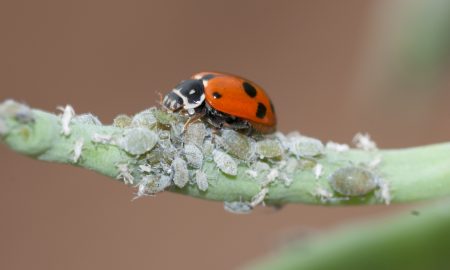While exceptionally large flights of native budworm moths continue to arrive in the southern and northern cropping zones, the rain may be washing away many of their eggs. In any case, monitoring is a must.
Where have they been found?
Recent reports indicate that native budworm (Helicoverpa punctigera) caterpillar populations are patchy between paddocks.
Threshold levels have been observed in some crops in the northern Mallee of Victoria. Further reports have had varied records from nil to 1-3 grubs/ 10 sweeps, with some occasionally higher in the same region.
Reports from near Gilgandra in the NSW Central West Slopes and Plains suggest that caterpillars are just becoming apparent.
Around Condobolin, 10-15 and 2-3 grubs/10 sweeps are being found in field peas and lupins, respectively, while very few have been observed in canola.
In the NSW Riverina, thresholds have been exceeded around Deniliquin.
Caterpillars have not yet emerged in many Victorian Wimmera crops in the Rupanyup area.
Threshold levels have been observed in paddocks south of Horsham.
Moth catches and forecasts
Recent moth trap catches reveal that native budworm moths have continued to arrive in large numbers in many areas of south-eastern Australia.
Weekly catch data can be viewed in the interactive MothTrapVis tool, which presents the relative size of moth catches in a sparsely distributed network of traps.
The tool is available to explore the changing distribution of moth catches this season.
Locations of trapping network for native budworm are marked with an x, which are visible in the absence of moths for the selected time period.
We previously used the DARABUG predictive model to estimate when eggs laid during the first major moth flights will hatch and reach the 3rd instar stage (see here). The predicted dates are location-specific, but were mostly around the early to mid October period. These dates provide an indication of the time to start monitoring for caterpillars in canola and pulses.
A large number of moths descending in our cropping zone will not always lead to a correspondingly large population of budworm caterpillars.
Research has shown that for those moth eggs laid a few days before any rain event, many will be washed off and destroyed.
About native budworm
Native budworm caterpillars vary substantially in colour that includes shades of brown, green and orange. Regardless of colour, they usually have darkish stripes along the body and bumpy skin with sparse, stiff, stout hairs.
One distinguishing feature of Helicoverpa caterpillars is the sharp downward angling at the rear of the body.
However, in contrast to cotton bollworm (Helicoverpa armigera) and lesser budworm (Heliothis punctifera), native budworm caterpillars have black hairs around the head and along the body.
Numbers of cotton bollworm appear to be relatively low in most parts of Victoria and southern NSW, which is not unusual. Nonetheless, growers should be mindful of the different species and confirm identify before deciding on the most appropriate management options. This is particularly important where cotton bollworm is present due to inherent insecticide resistance issues in this species.
Our advice
With the recent wet conditions experienced over much of Victoria and southern NSW, many eggs will perish.
Nonetheless, monitoring crops should begin from early podding, particularly after the predicted date for third instar caterpillars.
Monitor crops regularly using sweep nets; it is important to sample representative parts of the entire paddock before making a control decision. Taking multiples of 10 sweeps within at least five locations in a paddock is recommended. Importantly, young caterpillars can directly bore into pods if high temperatures are experienced, thus avoiding sweep nets (and insecticide sprays).
Economic thresholds for native budworm should be followed. These vary according to crop, control costs and anticipated crop return. Comprehensive, dynamic economic thresholds have been developed for native budworm in Western Australia. These should equally apply to south-eastern Australia.
Acknowledgements
We would like to thank the following trap operators:
Brad Bennett – Consultant, AGRIvision (Victorian Mallee)
Jim Cronin – Agronomist, Landmark (NSW Central West Slopes and Plains)
Adam Dellwo – Agronomist, Elders (NSW Riverina)
Bill Gardner – Agronomist and Grower (Victorian Wimmera)
Shayn Healey – Agronomist, Crop-Rite Pty Ltd (Victorian Mallee)
George Hepburn – Agronomist, Tylers Hardware & Rural Supplies (Victorian Wimmera)
Damian Jones – Agronomist, Agronomic Results (Victorian Mallee)
Jake Leith – Agronomist, AGRIvision (Victorian Wimmera)
David White – Agronomist, Delta Agribusiness (NSW Riverina)
Field reports
Brad Bennett – Consultant, AGRIvision (Victorian Mallee)
Shayn Healey – Agronomist, Crop-Rite Pty Ltd (Victorian Mallee)
George Hepburn – Agronomist, Tylers Hardware & Rural Supplies (Victorian Wimmera)
Matt Watt – Agronomist, Baker Ag Advantage, (NSW Central West Slopes & Plains)
Kent Wooding – General Manager, AGRIvision (Victorian Mallee)
Adam Dellwo (@AdamDellwo)
IMAG Agronomy (@IMAG_Consulting)
Cover image: Photo by Andrew Weeks, Cesar Australia





